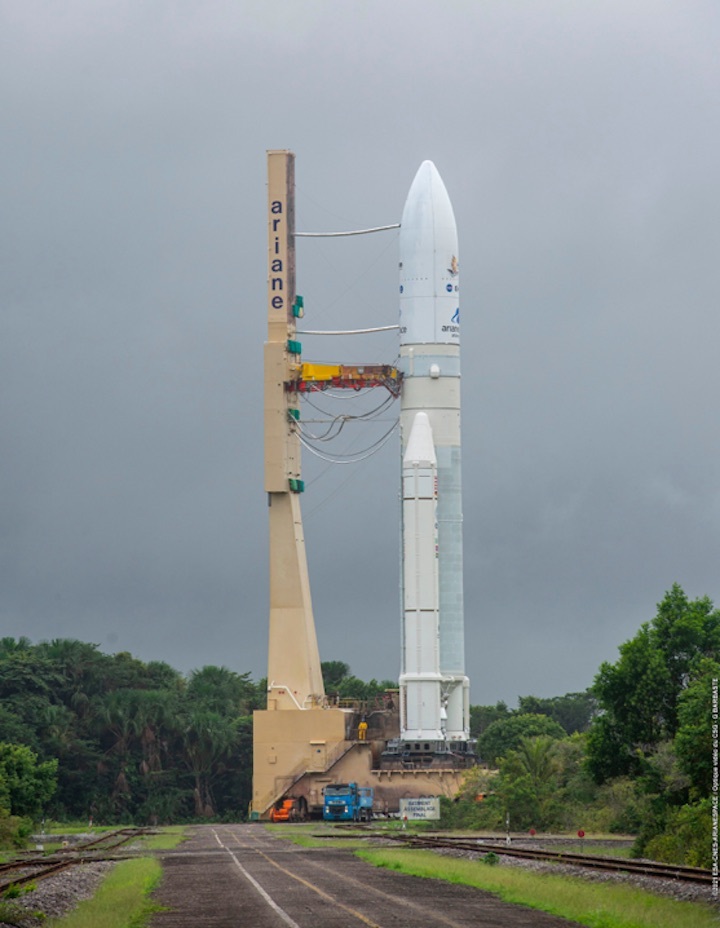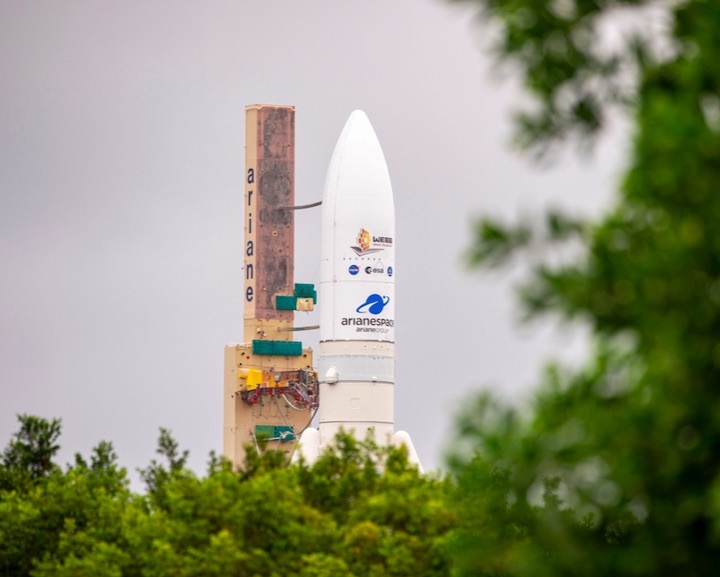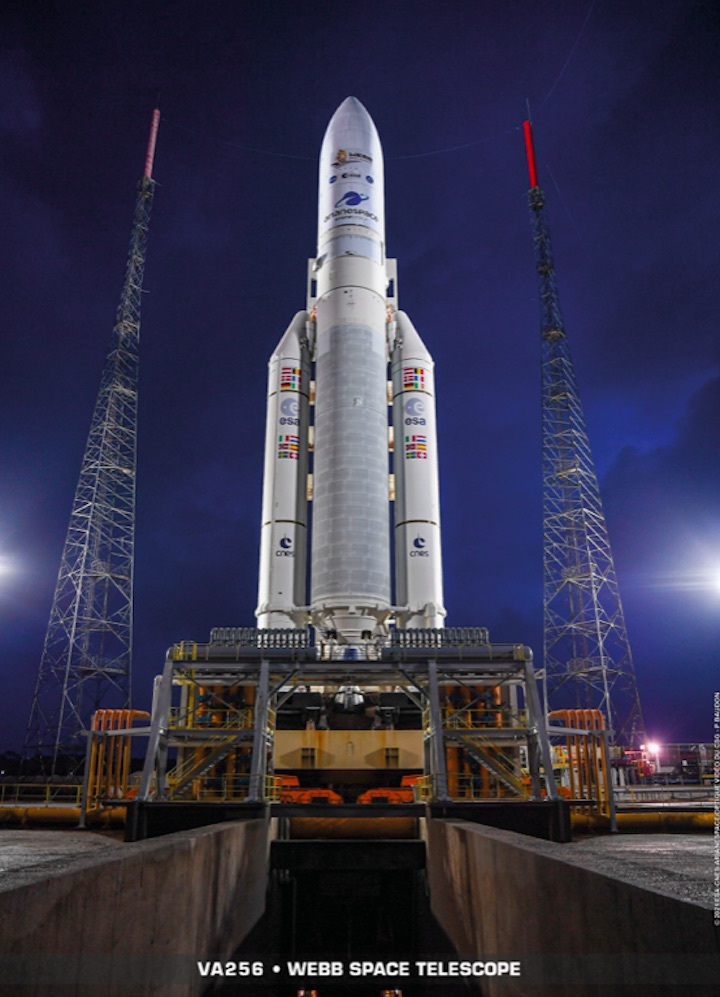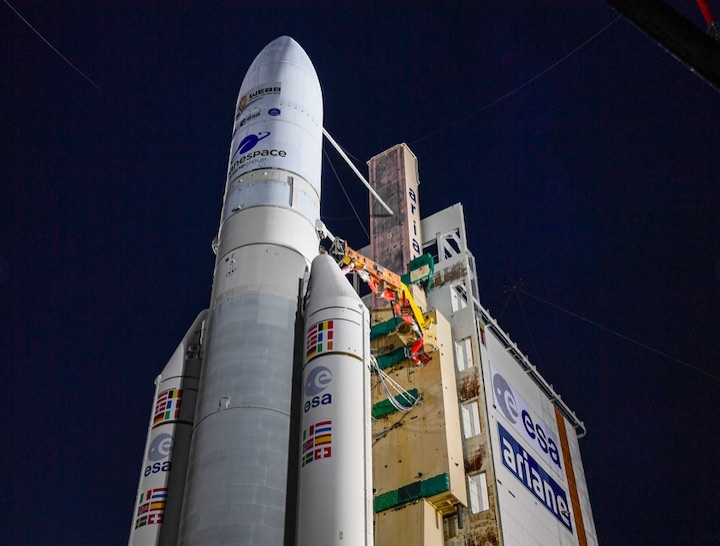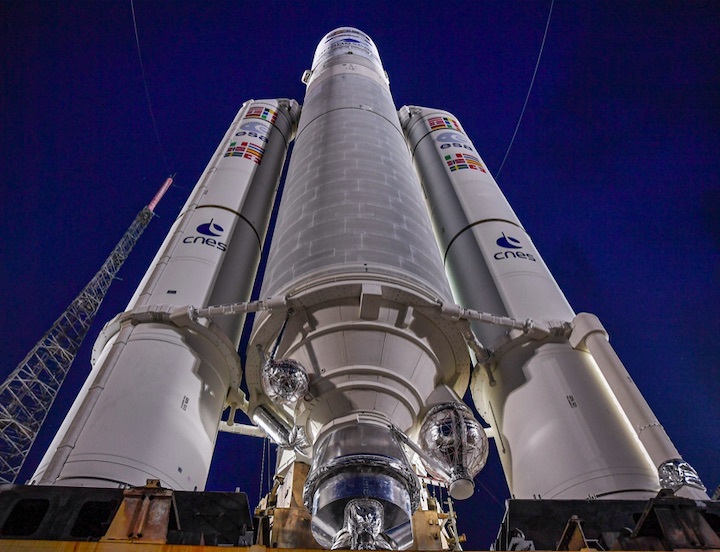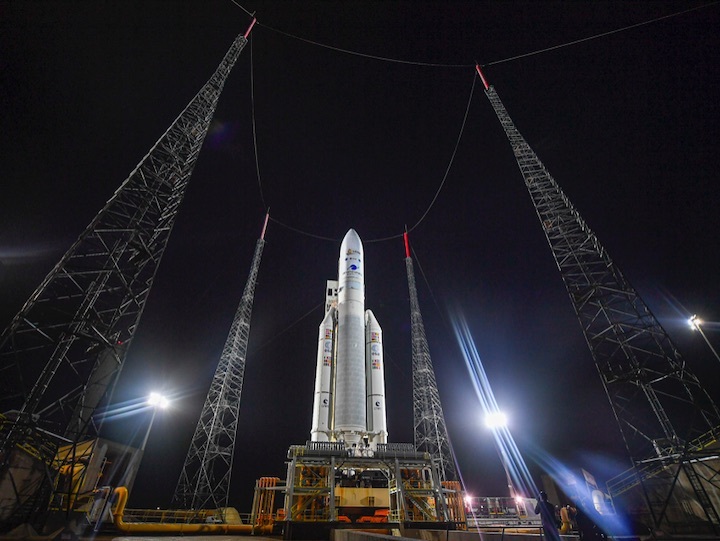14.12.2021
Pitt astronomers will be among the first to use the latest and greatest NASA telescope
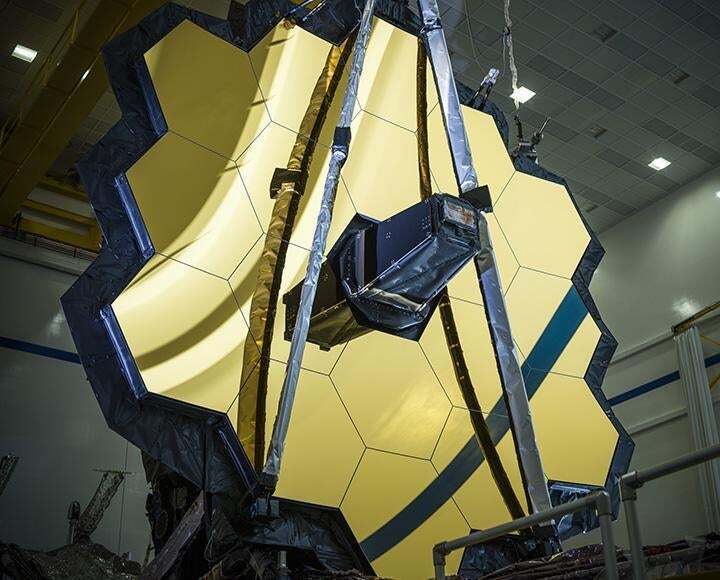
On Dec. 22, NASA will launch into space the successor to its Hubble telescope, a highly sensitive and astronomically expensive tool capable of seeing objects that are farther and fainter than ever before. It’ll unfold its 21-foot mirror and in a few months will begin beaming down the first of many captivating images, along with data that will keep scientists busy for years to come.
At least, that’s what Pitt astronomers hope. Four are among the researchers who have been granted highly sought-after time using the telescope in its first year in operation.
“It’s kind of a Hail Mary, but it’s a super exciting one,” said Physics and Astronomy Assistant Professor Rachel Bezansonin the Kenneth P. Dietrich School of Arts and Sciences. “This has been a very, very long time coming.”
The astronomy community has been waiting for NASA’s James Webb Space Telescope for decades, and Bezanson is more invested than most.
The project she co-leads, which she compares to the Hubble “deep field” program that produced arguably the telescope’s most iconic image, will point the Webb telescope at a particular patch of space for 30 hours, creating what a photographer might recognize as long-exposure shots of distant galaxies. What would make less sense to that photographer is that Bezanson’s team will look for faint, distant objects in a part of the sky area littered with close, bright galaxies.
“A huge collection of mass warps space so much that the light that travels through that space gets bent like a lens,” Bezanson said. “So we’re basically using that foreground collection of mass to boost the brightness of the things behind it and see even fainter objects than we otherwise would.”
Along with managing the project, Bezanson and her team at Pitt will transform the data delivered by the telescope into a form that’s usable for scientists. The images that emerge from that data will be one of the farthest glimpses Webb will reveal in its first year.
“We’re going to have the best chance of finding the most distant, craziest objects,” Bezanson said. As for what those objects will be? “Let’s be totally honest, we have no idea: We have never probed anything in these wavelengths at this kind of resolution before. We just haven’t had any kind of comparable tool.”
Searching for galactic winds
Before the telescope can start looking for galaxies, it has to launch into space. And that’s just the beginning of its precarious journey: Unlike its predecessor, Webb will revolve around Earth in an orbit so distant that it can’t be serviced by astronauts.
“There are 344 single-point failures,” Bezanson said — as in, 344 different ways the mission could go wrong. “It’s not just in the launch; it has to unfurl five layers of thin films the size of a tennis court.”
But that complexity, along with its distance from Earth and size, is what will lend Webb an unprecedented power and sensitivity to see far-away objects.
Its other superpower is the kind of light it can detect.
In the same way that an ambulance’s siren sounds deeper as it drives away, distant celestial objects look more red than they actually are because the space between them and the Earth is expanding. This effect is even more dramatic for the farthest objects: By the time their light reaches Earth, it’s been stretched past the red part of the light spectrum and into the infrared, invisible to the naked eye. Webb is designed to detect those infrared waves — and because the light from those distant objects has spent billions of years traveling to us, the new telescope will be able to show us regions of space as they existed when the universe was young.
That’s an especially exciting prospect to Evan Schneider, an assistant professor in Pitt’s Department of Physics and Astronomy. “The Milky Way is sort of a nice stable disc; it’s puttering along making one star every year,” she said. “But at much earlier cosmic epochs, everything was way more dramatic.”
The project Schneider is a part of, led by Susan Kassin of the Space Telescope Science Institute, will use Webb to study these early galaxies. Schneider, an expert on the theory of how galaxies evolve over time, is particularly interested in the gas that galaxies shoot out early in their evolution, a feature called galactic winds.
In the past few decades, Schneider said, researchers have come to believe that as galaxies form they constantly shoot out gas due to the force of exploding stars. Armed with both Webb’s power to peer into the early universe and its ability to tease apart light waves into their component parts, researchers will be able to tell how much gas the galaxies were ejecting in their early days. That should let them confirm whether their recent theorizing has been on the right track.
“We think that in really early times, everything was much more chaotic — all of this bursty star formation and feedback was going on,” Schneider said. “But we haven't been able to actually measure these things at early times, because you need a telescope like James Webb to do it.”
‘At the mercy of these exploding stars’
Rather than staring deeply at one patch of space, Department of Physics and Astronomy Associate Professor Carles Badenes is part of a project that will sneak in minutes throughout the telescope’s first year. There’s a simple reason for that: They don’t yet know where they’ll need to look.
“A typical supernova explodes in a matter of seconds, and then half a year later, the supernova has faded quite a bit. That is when you want to catch them,” Badenes said.
Badenes studies a poorly understood process that happens when cooled-off stars known as white dwarves explode. By the time one of these explosions has dimmed, it has also spread out enough that a telescope can peer right through it, giving them the moniker “see-through supernova.”
It’s blink-and-you’ll-miss-it astronomy, and a unique chance for scientists to see the inner workings of a stellar phenomenon. Wielding Webb’s ability to split apart light waves, Badenes and his colleagues, led by Saurabh Jha at Rutgers University, will be able to understand the chemical composition of these exploding stars. They’ll even be able to measure how quickly supernovae eject material into their surroundings.
“We know these are exploding white dwarves of some kind, but we don’t understand exactly the why and exactly the how,” Badenes said. Webb will give them a chance to answer those questions. Hopefully.
“We’re all at the mercy of these exploding stars,” Badenes said. “They have to go off. If they don’t, then no luck.”
Other programs in Webb’s first year are less concerned with specific phenomena and more aimed at getting as much mileage out of the telescope as possible — like PRIMER, a project that includes Department of Physics and Astronomy Professor Jeffrey Newman.
“The strategy for PRIMER is to cover as much sky as we can,” Newman said.
One problem with staring into an unknown part of space is that the patch of sky you choose might just be a dud. “If you look at a small area of the universe, you may be lucky or unlucky,” Newman said. “That region may have been a high-density part of the universe or low-density part of the universe.”
Newman’s role in PRIMER is to help determine how best to use Webb, minimizing the chance that they’ll find nothing at all of interest. They’ll look to collect data on a broad cross-section of early galaxies in many different wavelengths of light across two patches of sky. The search will provide a bigger picture of how galaxies looked a when the universe was much younger.
And as researchers pore through the resulting information, they’ll find intriguing objects to follow up on later. “But first, we need to find the interesting ones,” Newman said. “PRIMER is really intended to be the discovery engine that allows us to do that.”
Projects like Bezanson’s and Newman’s are poised to produce so much data that the team’s researchers couldn’t possibly analyze it all themselves. It’s one of the many extremes of science that researchers are pushed to, due to the competitive nature of applications for time with Webb. All are large teams with painstakingly economical plans for using the telescope’s precious minutes, and generous plans for making their data available to the public.
If you want a crack at a state-of-the-art telescope, there’s no room for hoarding what you find.
“This is in the DNA of astrophysics: We share our tools,” said Bezanson. “I’m really interested to see what some other group will do with the same dataset, because the way they ask the questions is inevitably going to be different. That combination gives you a rich understanding.”
And the projects Pitt scientists are a part of are only a fraction of the science that will happen in the telescope’s first year. Making sense of what Webb beams back to Earth will be a global effort — and one that won’t stop anytime soon.
“These things have longevity because there are just a million questions you can ask once you have lots of imaging,” Bezanson said. “This will set the field up for decades.”
Quelle: University of Pittsburgh
----
Update: 15.12.2021
.
NASA: Webb telescope launch delayed by communication problem
Next week's launch of NASA's new space telescope is delayed for at least two days because of a communication problem between the observatory and the rocket
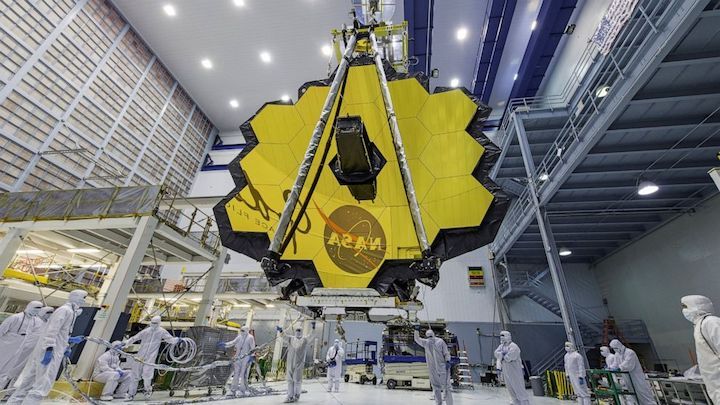
CAPE CANAVERAL, Fla. -- Next week’s launch of NASA’s new space telescope is delayed for at least two days because of a communication problem between the observatory and the rocket.
Liftoff of the James Webb Space Telescope is now targeted for no earlier than Dec. 24. NASA announced the latest delay for the $10 billion telescope late Tuesday. More information will be available later this week, officials said.
Webb is awaiting launch aboard an Ariane rocket at the European Space Agency's spaceport in French Guiana. The telescope had been put on top of the rocket last Saturday. Liftoff had been scheduled for Dec. 22.
Webb is considered the successor to the Hubble Space Telescope and has already been delayed by years.
Quelle: abcNews
+++
James Webb telescope lifted atop its launch rocket
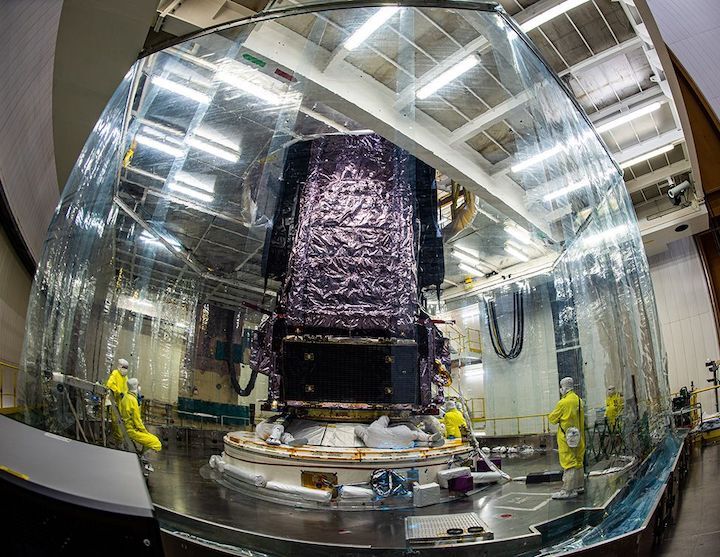
The James Webb Space Telescope (JWST) has been hoisted atop the rocket that will blast it into orbit.
Weighing more than six tonnes, the $10bn successor to the legendary Hubble observatory was lifted by a crane and edged into position using guide lasers.
Webb is the single most expensive space science experiment ever conceived.
Its huge mirror and super-sensitive instruments will try to spy the first stars to shine in the Universe more than 13.5 billion years ago.
Other work will see it probe the atmospheres of distant planets to look for signs of life.
The pictures on this page are among the last we will see of Webb on Earth.
Lift-off had been scheduled for Wednesday 22 December, but issues related to the electrical interface between Webb and the rocket following mating mean the ascent to space won't now happen before Friday 24 December.
JWST is a US space agency (Nasa) venture, but the task of launching it has been given to the European Space Agency (Esa), which is a partner on the project along with the Canadian Space Agency (CSA).
Esa is using the dependable Ariane-5 for the job. The vehicle operates out of the Kourou spaceport in French Guiana.
Engineers at the spaceport have been preparing the telescope and rocket in parallel and only brought them together into the same building last week.
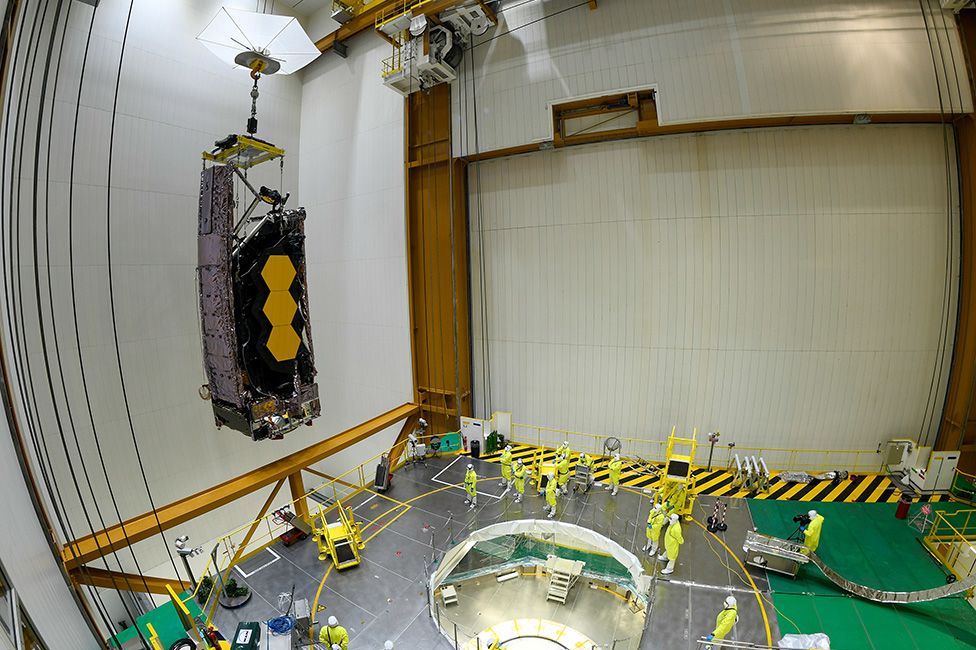 IMAGE SOURCE, MANUEL PEDOUSSAUT
IMAGE SOURCE, MANUEL PEDOUSSAUTThe crane manoeuvres required to mate the pair required millimetric precision. A "shower curtain" was put around Webb during the work of attachment to keep the observatory and its mirrors super-clean.
Not shown on this page is the next stage - the activity of encapsulation, the placement of Ariane's nosecone, or fairing, over the top of Webb. This activity was scheduled to be completed on Tuesday.
The fairing, which will protect Webb during the first three minutes of its ascent to space, only just fits around the telescope.
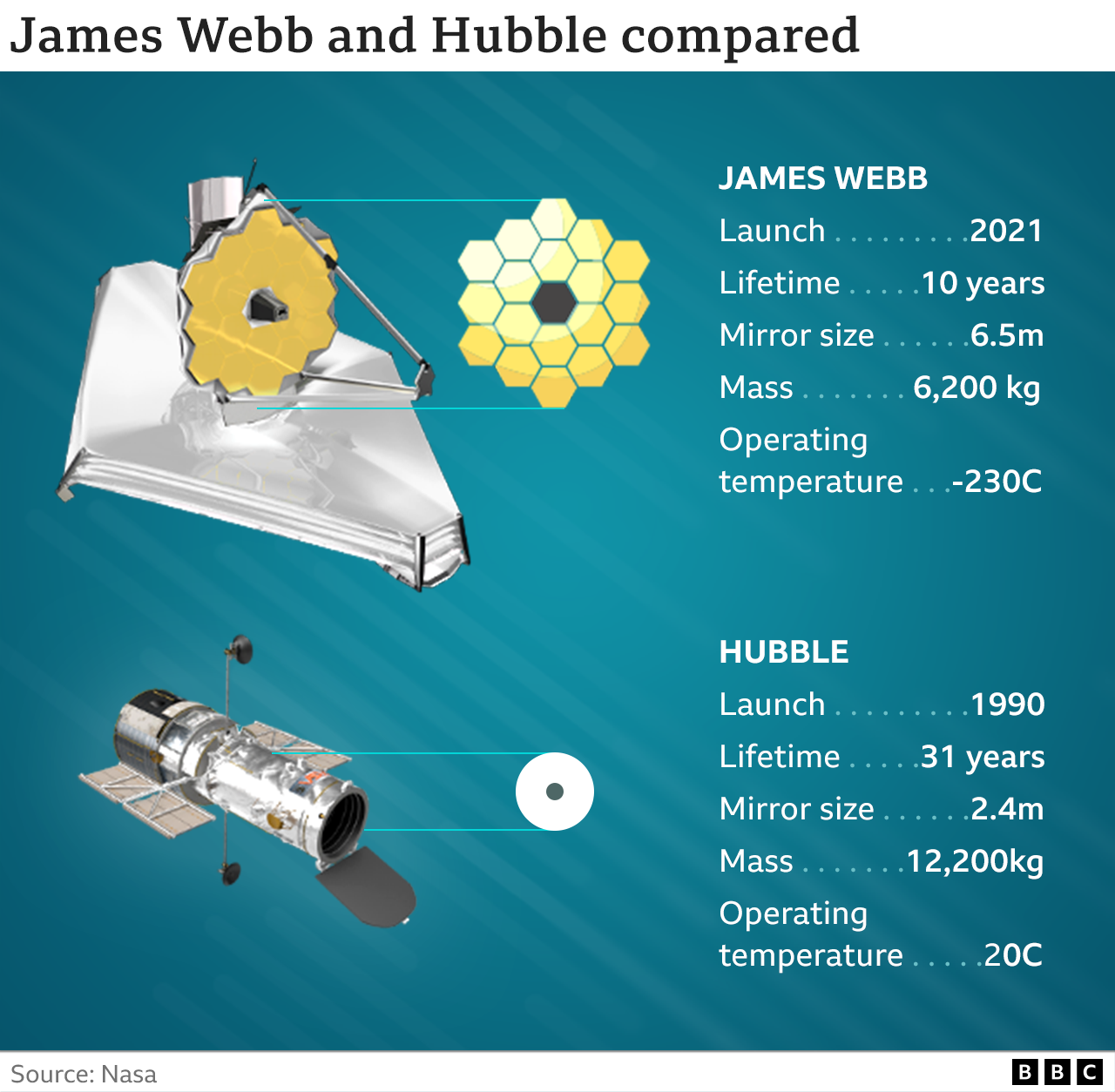
Webb, in its folded launch configuration, is a rectangular box measuring 10.6m (35ft) by 4.5m by 4.5m. This leaves a mere 15-20cm gap to the inner surface of the nosecone. And under launch loads, when everything is vibrating, this separation will be reduced still further to as little as 9cm.
Webb will continue to be monitored in the days up to lift-off.
There are access points in the fairing, explains Esa Webb project manager Peter Rummel.
"This means we can purge the inside using very dry, super-clean air. We can also put in sensors to look for any contamination. And of course we switch on the telescope to check everything continues to be OK," he told BBC News.
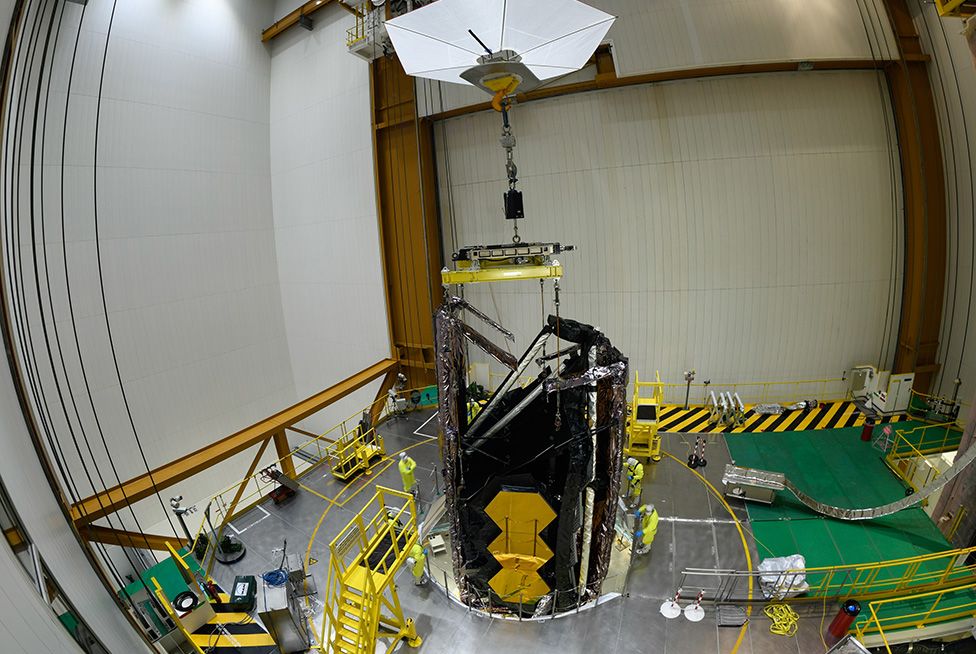 IMAGE SOURCE, MANUEL PEDOUSSAUT
IMAGE SOURCE, MANUEL PEDOUSSAUTThe Ariane carries a number of modifications for the upcoming flight. In particular, special vents have been put in the sides of the fairing to ensure there is an even loss of pressure during the climb to orbit. This will ensure there is no abrupt change in environment that might damage the telescope when the fairing is discarded.
The rocket will throw Webb on to a path that will take it to an observing station some 1.5 million kilometres from Earth.
This journey should last a month, during which time Webb's 6.5m-diameter primary mirror and tennis court-sized sunshield will be unfolded.
The telescope has been designed to image the earliest objects to form after the Big Bang.
These are theorised to be colossal stars, grouping together in the first galaxies.
"There's speculation that these massive early stars might quickly collapse into black holes," explains Prof Andy Bunker from Oxford University.
"More massive stars will undergo rapid core collapse, which we call a supernova event. We see those as stellar explosions. But there is a sweet spot in terms of stellar mass where the star might collapse directly to a black hole. So-called direct-collapse black holes have been predicted but never seen observationally. Webb may give us the evidence, albeit indirectly."
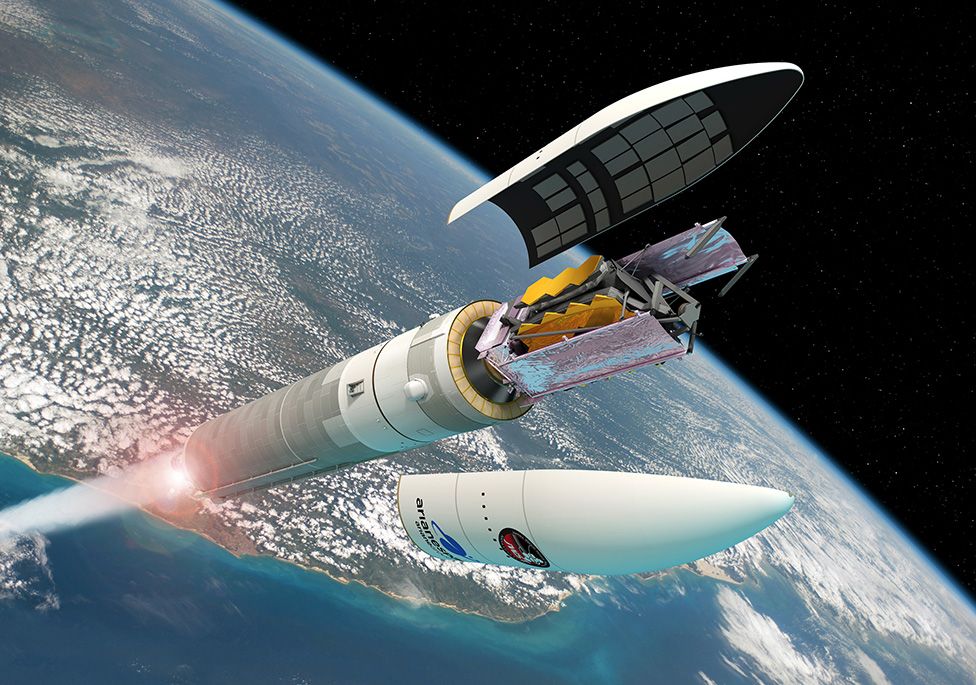 IMAGE SOURCE, DAVID DUCROS
IMAGE SOURCE, DAVID DUCROS+++
NASA delays launch of Webb telescope to no earlier than Dec. 24
Engineers discovered an intermittent data dropout associated with a piece of ground support equipment after connecting the James Webb Space Telescope with its Ariane 5 launcher over the weekend in French Guiana. The observatory’s long-awaited blastoff will be delayed at least two days to Dec. 24 to troubleshoot the problem, the head of NASA’s science division said Tuesday.
The mission was previously set for takeoff Dec. 22 from the European-run Guiana Space Center in Kourou, French Guiana, on the northeastern coast of South America. A final step in preparation for Webb’s blastoff occurred Saturday, when the observatory was raised atop its Ariane 5 launch vehicle.
But a technical issue held up the next step in the launch campaign. The Ariane 5’s Swiss-made payload shroud was supposed to be lowered over the three-story-tall observatory Monday.
In a brief statement, NASA wrote on its website late Tuesday that the Webb team is “working a communications issue between the observatory and the launch vehicle system.”
Thomas Zurbuchen, associate administrator for NASA’s science mission directorate, said Tuesday that engineers found an “interface problem” in a system that communicates with Webb while it’s on top of the Ariane 5 rocket.
“The way to think about it is it’s a ground support equipment thing,” Zurbuchen said Tuesday night in an interview with Spaceflight Now. “Basically, the data cables are dropping some frames.”
Technicians inside the Ariane 5 rocket’s final assembly building in Kourou have tried to diagnose the problem, but so far, haven’t been able to resolve it.
“Tomorrow, we’re going up there with the ground support equipment, and just really making sure we can flush out where the issue is,” Zurbuchen said. “We’ve tried a bunch of things, and we just haven’t been successful. This is a 100-meter cable that goes all the way from the top of the rocket to somebody’s computer. Somewhere in there (is the problem), is our guess.
“But it’s too early to say,” he said. “We need to go after it tomorrow, and put some specific equipment into play … The way these things work, once you find it, it’s easy.”
Webb is a once-in-a-generation mission with a development cost of roughly $9.7 billion, making it the most expensive scientific spacecraft ever launched. Its foldable telescope will open to a span of more than 21 feet (6.5 meters) once in space, making Webb the largest space-based observatory in history.
The James Webb Space Telescope will ride the Ariane 5 on a half-hour ascent into space, beginning a journey to the observatory’s distant operating orbit near the L2 Lagrange point, a gravitationally-neutral location about four times farther from Earth than the moon.
After a series of crucial deployments of its sunshield and mirror array, Webb will begin peering deeper into the universe than any telescope before, probing the first galaxies and stars that formed after the Big Bang more than 13 billion years ago.
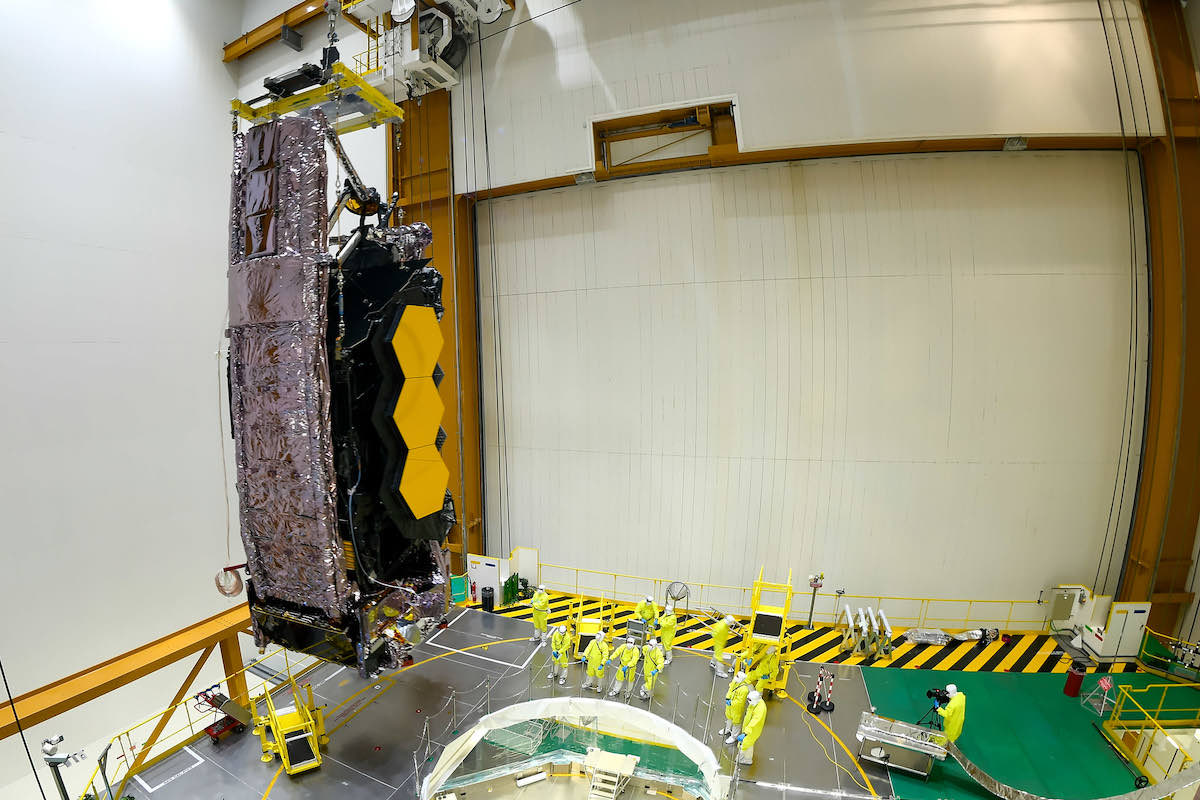
Ground teams encountered similar communications interface issues during preparations for recent launches of two smaller NASA missions, the DART asteroid deflection experiment and the IXPE X-ray astronomy mission, Zurbuchen said. Those missions were a bargain compared to Webb, with costs of $330 million and $214 million, respectively.
Those experiences show that technical glitches during launch processing are not unusual. Managers decided to go ahead with those launches, without incident.
“But if it’s Webb, we’re going to figure it out. We’re not gonna let anything stand. So for that reason, we can only encapsulate (Webb inside the payload fairing) Friday, and that basically moves the launch to no earlier than the 24th.”
Zurbuchen cautioned that the new Dec. 24 launch date is preliminary, but NASA wanted to announce the tentative new schedule before teams complete troubleshooting. NASA said it will provide more information about the Webb launch date no later than Friday.
“Many people have their holiday schedules related to what happens with Webb,” Zurbuchen said.
Officials hope to launch the Webb mission Dec. 24, but NASA and the European Space Agency have agreed to make a launch attempt for Webb on Christmas Day, if necessary, pending final agreement from CNES, the French space agency, according to Zurbuchen. CNES operates the launch range at the Guiana Space Center.
Thierry Wilmart, Arianespace’s mission director for the Webb launch, said last week the rocket teams could also attempt launch Dec. 25, if necessary. Arianespace is the French commercial launch services provider for Ariane 5 missions.
The Webb telescope has daily half-hour launch windows, all opening around 7:20 a.m. EST (1220 GMT; 9:20 a.m. Kourou time), through Jan. 6.
If the mission is still on the ground then, the launch would have to wait until around Jan. 13 to avoid the possibility of Webb passing too close to the moon on its way to the L2 Lagrange point nearly a million miles from Earth. Lunar gravity could bend the spacecraft’s trajectory, requiring it to burn more fuel on the journey.
Quelle: SN
----
Update: 18.12.2021
.
Webb telescope testing on tap before setting target launch date
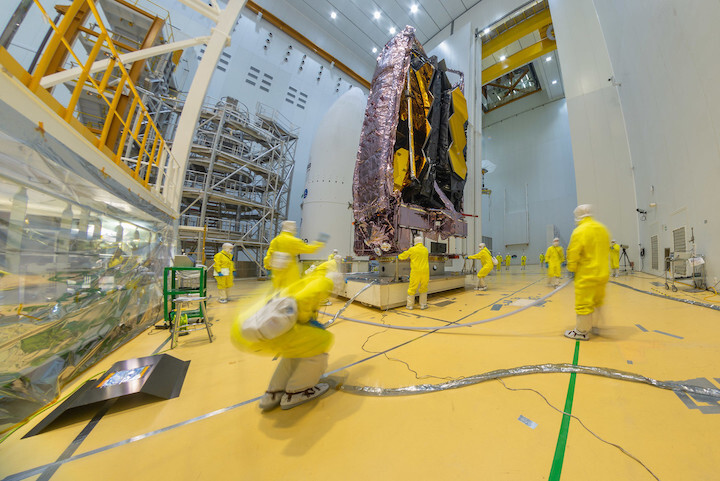
Technicians at a jungle spaceport in South America are completing tests on the James Webb Space Telescope Thursday to make sure they fixed a “finicky” communications interface glitch that halted launch preparations earlier this week.
NASA and European Space Agency officials will confirm the mission’s target launch date — currently penciled in for no earlier than Dec. 24 — as soon as Friday.
Officials said Thursday morning they didn’t want to officially announce a new target launch date until teams in French Guiana finished an “aliveness” test of the Webb telescope, already mounted on top of its Ariane 5 rocket inside a hangar.
“We’re not taking any risks with Webb,” said Thomas Zurbuchen, head of NASA’s science mission directorate. “It’s already risky enough the way it is. We’re absolutely making sure everything works.”
Webb cost NASA, ESA and the Canadian Space Agency around $9.7 billion to design and develop since the 1990s. The once-in-a-generation mission will the most expensive scientific instrument ever shot into space.
Crews at the Guiana Space Center in Kourou, French Guiana, hoisted the Webb telescope on top of its European Ariane 5 launcher Saturday, Dec. 11. But teams discovered intermittent data dropouts in a communications interface between the observatory and the launch system.
A data cable routes signals from the telescope down the length of the rocket and through the Ariane 5 launch platform. The connection is a piece of ground support equipment, meaning it’s only used on the ground before liftoff.
Zurbuchen said NASA engineers are leading the effort to troubleshoot the problem, with assistance from ESA and Arianespace, the rocket’s launch service provider.
“We believe they have found (the communications interface issue), but the proof is in the pudding,” Zurbuchen said Tuesday. “The thing needs to go through the aliveness test successfully before we say (we can proceed).”
These things happen in the launch business, Zurbuchen said. “It’s just when it’s Webb, there are no small problems.”
Managers planned to meet at 6 p.m. EST (2300 GMT) Thursday to discuss whether to go forward with the launch campaign. Officials announced earlier this week that the launch of Webb would be delayed from Dec. 22 to no earlier than next Friday, Dec. 24, to allow time for the unplanned troubleshooting.
The launch was previously delayed from Dec. 18 after a clamp band connecting Webb with its payload adapter inadvertently opened during processing inside a clean room at the French Guiana spaceport. Managers ordered extra tests to make sure the observatory wasn’t damaged from vibrations induced during the incident, and Webb came back with a clean bill of health.
Zurbuchen said he was “pretty optimistic’ about Webb being cleared for the rest of the launch campaign.
“But don’t take that to the bank yet,” he said. “We need to get through that test.”
If the testing Thursday finished on schedule, ground crews could encapsulate Webb inside the Ariane 5 rocket’s Swiss-made payload fairing Friday. A crane will lower the nose shroud over the observatory on top of the Ariane 5 launcher, completing assembly of the rocket that will send Webb toward its operating post in orbit around the L2 Lagrange point, a gravitationally-stable location four times farther than the moon.
“Nothing is routine about Webb, but it’s a lot more routine after that because the spacecraft is now encapsulated, and it’s mostly rocket stuff,” Zurbuchen said. “And with the tremendous track record that ESA and Arianespace have, a launch date can be established.”
“When a spacecraft is on top of the rocket, you want to get it off the planet as soon as possible, after you do all the checks,” Zurbuchen said.
NASA said earlier Thursday that officials would release an update on Webb’s launch date Thursday night. Zurbuchen tweeted later in the day that an update on the schedule won’t come until Friday.
Webb is the largest space telescope in history, 100 times as powerful as the 30-year-old Hubble Space Telescope. It’s folded up to fit inside the 17.7-foot (5.4-meter) diameter of the Ariane 5 rocket’s nose cone, the widest fairing of any currently operational launch vehicle.
Once in space, the observatory will deploy a solar panel, unfurl high-gain communications antenna, and then open a five-layer thermal to block heat and light from the sun from reaching the telescope’s mirrors and infrared detectors. Then Webb will open two wings to finish setting up the telescope’s primary mirror, which spans more than 21 feet (6.5 meters) in diameter.
The primary mirror is made up of 18 individual hexagonal segments. Each mirror segment is made of beryllium and coated in a thin layer of gold to aid reflectivity. Working in unison, the 18 mirrors will focus light on a secondary mirror, and then into the observatory’s instrument module, which houses detectors chilled as cold as minus 447 degrees Fahrenheit, just 7 degrees above absolute zero.
Webb will seek out light from the first galaxies after the Big Bang nearly 13.7 billion years ago. The observatory’s instruments will also study the atmospheres of planets around other stars, revealing which ones might be habitable.
“Are we alone? Is Earth unique? Do we have other planets out there that can host life?” said Antonella Nota, ESA’s project scientist for Webb, in a press conference Thursday. “Very ambitions questions that speak to all of us. So Webb will study in detail the atmospheres of these exoplanets and we are looking for elements like methane, oxygen, water — the building blocks for life.”
Quelle: SN
+++
Webb Space Telescope Launch Date Update
The James Webb Space Telescope team is working a communication issue between the observatory and the launch vehicle system. This will delay the launch date to no earlier than Friday, December 24.
The James Webb Space Telescope has been encapsulated inside its
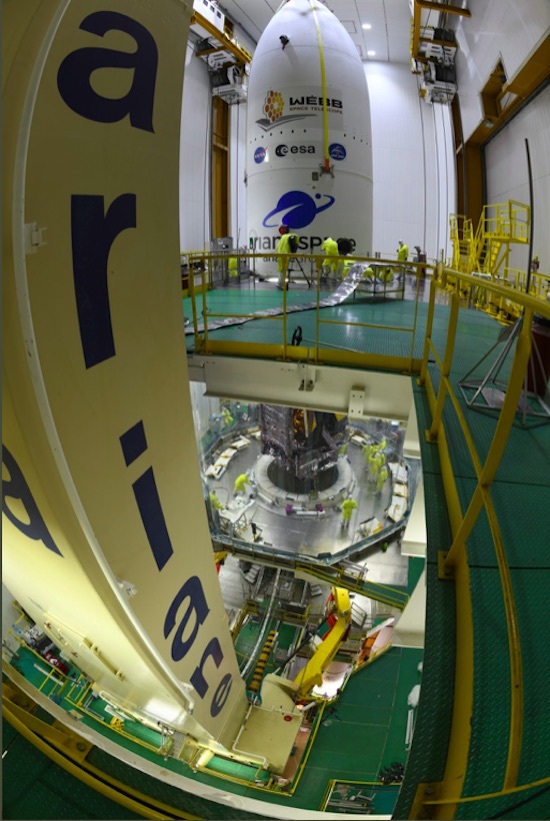
NASA confirms next Friday for Webb Space Telescope launch
NASA is shooting for next Friday to launch its newest space telescope
CAPE CANAVERAL, Fla. -- NASA is shooting for next Friday — Christmas Eve — to launch its newest space telescope.
NASA Administrator Bill Nelson confirmed Friday that the James Webb Space Telescope will attempt to blast off on Dec. 24. A European Ariane rocket will provide the lift from South America’s French Guiana.
The $10 billion Webb — considered the successor to the Hubble Space Telescope — was supposed to soar Saturday, but was jolted by a clamp during launch preparations, resulting in a four-day delay. Then a bad communication link on the rocket had to be fixed, postponing the launch another two days.
U.S. and European space officials signed off Friday on the launch date, following one last round of testing.
Nelson expects a smaller crowd at the launch site because of the holidays. Liftoff is scheduled for 7:20 a.m. EST.
“Since it’s Christmas Eve, all the congressional delegations that were going down, all of that has evaporated,” he told The Associated Press. Even the NASA and contractor team has dwindled, he noted. But he'll be there.
Already years late in flying, Webb will look back to almost the beginning of time, to when the first stars and galaxies were forming, while also examining the atmospheres of planets orbiting stars closer to home. NASA is partnering with the European and Canadian space agencies on the mega project.
“There’s so much riding on this," Nelson said, “opening up just all kinds of new understanding and revelations about the universe."
Is there a better Christmas present than seeing the telescope launch? Nelson answered by breaking into song: “All I want for Christmas are not my two front teeth, but for the success of JWST” -- referring to the telescope by its acronym.
Quelle: abcNews
----
Update: 20.12.2021
.
Webb launch confirmed for 24 December
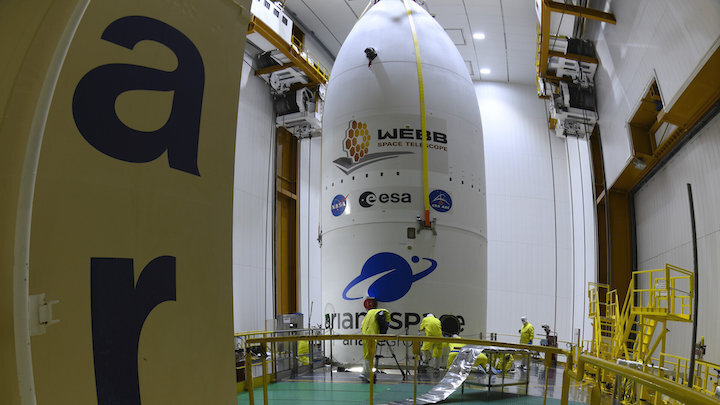
The James Webb Space Telescope is confirmed for the target launch date of 24 December, at 12:20 GMT / 13:20 CET.
Late yesterday, teams at the launch site successfully completed encapsulation of the observatory inside the Ariane 5 rocket that will launch it to space. Webb’s launch final readiness review will be held on Tuesday 21 December and, if successful, roll-out is planned for Wednesday 22 December.
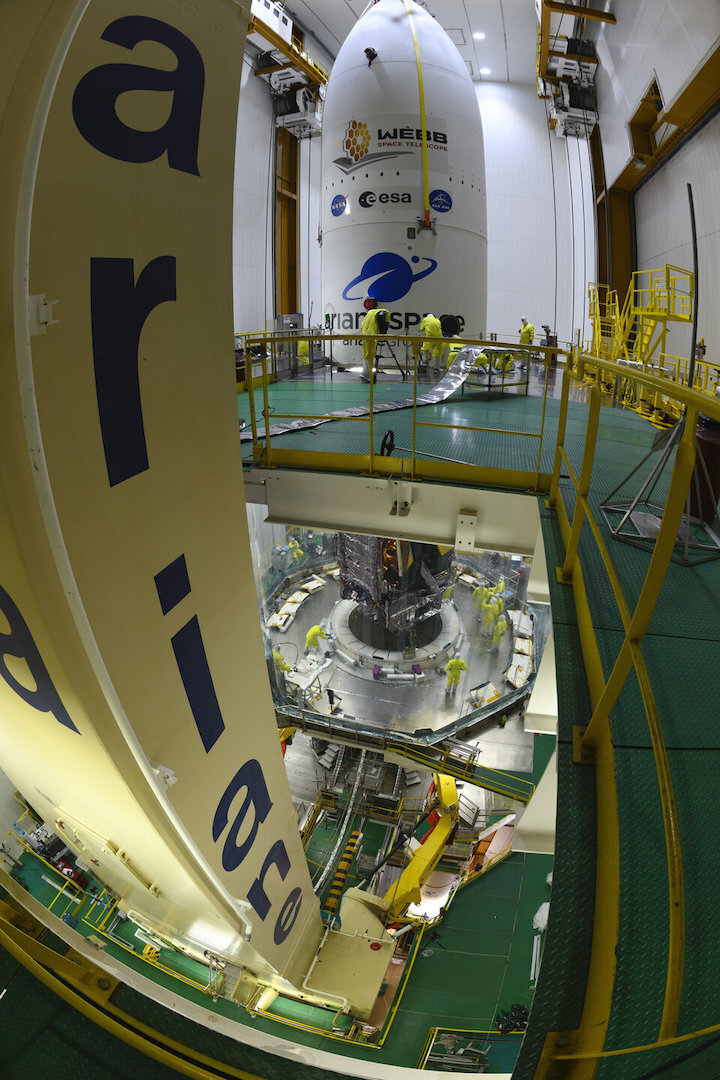
Webb encapsulated inside Ariane 5
Quelle: ESA
----
Update: 21.12.2021
.
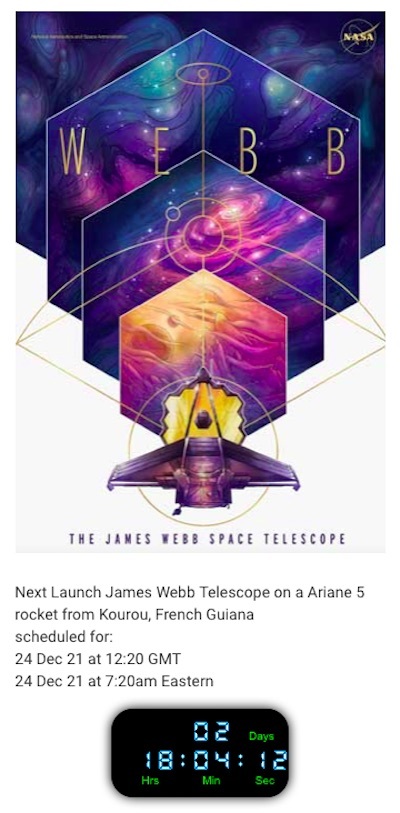
----
Update: 22.12.2021
.
Flight VA256: new target launch date
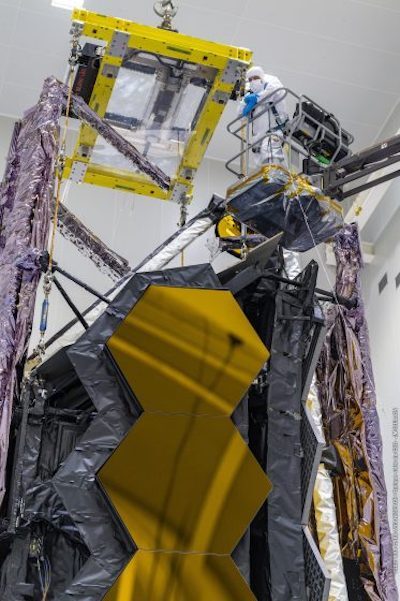
Today, December 21st, the Launch Readiness Review has been successfully completed and concluded with the authorization to perform the launch vehicle rollout and the start of the launch chronology.
However, due to adverse weather conditions at Europe’s Spaceport in French Guiana, the flight VA256 to launch the James Webb Space Telescope –initially scheduled for December 24– is being postponed.
The new targeted launch date is December 25, as early as possible within the following launch window:
> Between 07:20 a.m. and 07:52 a.m. Washington, D.C. time,
> Between 09:20 a.m. and 09:52 a.m. Kourou time,
> Between 12:20 p.m. and 12:52 p.m. Universal time (UTC),
> Between 01:20 p.m. and 01:52 p.m. Paris time,
> Between 09:20 p.m. and 09:52 p.m. Tokyo time.
Tomorrow evening, local time, another weather forecast will be issued in order to confirm the date of December 25. The Ariane 5 launch vehicle and Webb are in stable and safe conditions in the Final Assembly Building.
Quelle: arianespace
----
Update: 24.12.2021
.
NASA, Partners Complete Webb Rocket Rollout
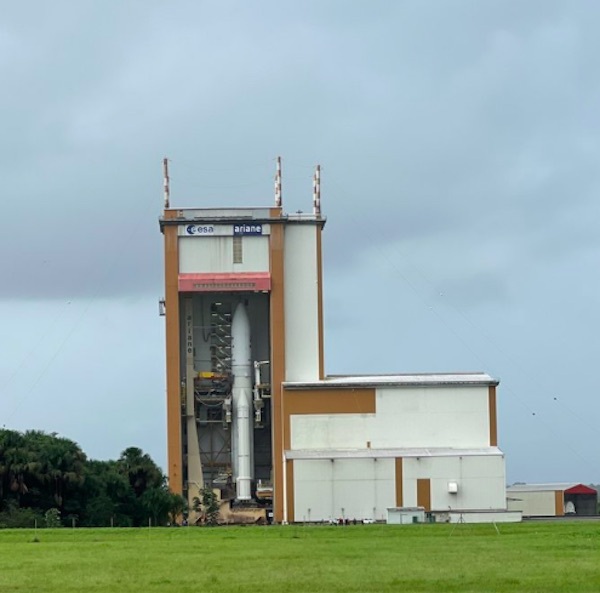
NASA’s James Webb Space Telescope – inside the Ariane 5 rocket it will ride to space – has arrived at its final location on Earth: the Arianespace ELA-3 launch complex at Europe’s Spaceport located near Kourou, French Guiana. Webb is scheduled for liftoff at 7:20 am EST Saturday, Dec. 25. With Webb and its rocket securely on the pad, the team will run electrical diagnostics to ensure all lights are green for launch. Teams will power on the observatory while at the launch pad to run one final aliveness test to ensure all systems have power and are working before liftoff.
Quelle: NASA
+++
